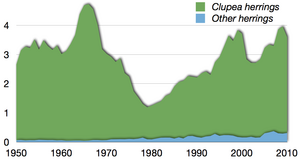Haring


Haring atau herring merupakan ikan pelagik kecil yang menjadi makanan predator yang lebih besar darinya; sebagian besar ikan haring termasuk keluarga Clupeidae.
Mereka sering bergerak dalam kawanan besar di sekitar bagian laut yang dangkal (seperti gosong pasir atau gunung bawah laut) dan dekat pantai. Spesies yang paling berlimpah jumlahnya dan penting secara komersial adalah yang termasuk dalam genus Clupea, utamanya terdapat di perairan beriklim sedang dan dangkal pada Samudra Pasifik Utara dan Atlantik Utara, termasuk Laut Baltik, serta lepas pantai barat dari Amerika Selatan. Ada tiga spesies Clupea yang telah dikenali, dan memberi kontribusi sekitar 90% dari seluruh penangkapan ikan haring dalam perikanan. Yang paling banyak dari semuanya adalah haring atlantik, kontribusinya lebih dari separuh dari seluruh penangkapan haring. Ikan-ikan yang disebut haring juga ditemukan di India, di Laut Arab, Samudra Hindia dan Teluk Benggala.
Ikan haring memainkan peran penting dalam sejarah perikanan laut di Eropa,[2] dan di awal abad ke-20 penelitian atas ikan-ikan tersebut menjadi dasar bagi evolusi ilmu perikanan.[3][4] Ikan berminyak[5] ini juga mempunyai sejarah panjang sebagai suatu ikan makanan yang penting, dan sering kali diasinkan, diasapkan, atau diasamkan.
Lihat pula
- Hering merah (suatu ungkapan, tidak relevan)
- Kipper
Referensi
Catatan
- ^ Based on data sourced from the relevant FAO Species Fact Sheets Diarsipkan 2009-05-08 di Wayback Machine.
- ^ Cushing, David H (1975) Marine ecology and fisheries Diarsipkan 2023-08-16 di Wayback Machine. Cambridge University Press. ISBN 978-0-521-09911-0.
- ^ Went, AEJ (1972) "The History of the International Council for the Exploration of the Sea". Proceedings of the Royal Society of Edinburgh. Section B. Biology, 73: 351–360.DOI:10.1017/S0080455X0000240X
- ^ Pauly, Daniel (2004) Darwin's Fishes: An Encyclopedia of Ichthyology, Ecology, and Evolution Diarsipkan 2023-08-16 di Wayback Machine. Page 109, Cambridge University Press. ISBN 978-0-521-82777-5.
- ^ "What's an oily fish?". Food Standards Agency. 2004-06-24. Diarsipkan dari versi asli tanggal 2010-12-10. Diakses tanggal 2015-08-11.
Bibliografi
- Froese, Rainer and Pauly, Daniel, eds. (2006). Species of Clupea di FishBase. Versi January 2006.
- Dewhurst HW (1834) Clupea harengis or the common herring Diarsipkan 2023-08-16 di Wayback Machine. In: The Natural History of the Order Cetacea, Oxford University. Pages 232–246.
- Geffen, Audrey J (2009) Advances in herring biology: from simple to complex, coping with plasticity and adaptability: Diarsipkan 2013-04-15 di Archive.is ICES Journal of Marine Science, 66 (8): 1688–1695.
- Gilpen JB (1867) "On the common herring (Clupea elongata)" Diarsipkan 2016-03-03 di Wayback Machine. Proceedings and Transactions of the Nova-Scotian Institute of Natural Science, 1 (1): 4–11.
- O'Clair, Rita M. and O'Clair, Charles E., "Pacific herring," Southeast Alaska's Rocky Shores: Animals. pg. 343-346. Plant Press: Auke Bay, Alaska (1998). ISBN 0-9664245-0-6
- Stephenson RL (2001) The role of herring investigations in shaping fisheries science Diarsipkan 2013-05-16 di Wayback Machine. In F. Funk, J. Blackburn, D. Hay, A.J. Paul, R. Stephen- son, R. Toresen, and D. Witherell (eds.) Herrings: Expectations for a New Millennium, Alaska Sea Grant College Program. AK-SG-01-04. Pages 1–20. ISBN 1-56612-070-5.
- Stephenson, R. L., Melvin, G. D., and Power, M. J. (2009) "Population integrity and connectivity in Northwest Atlantic herring: a review of assumptions and evidence" Diarsipkan 2013-04-15 di Archive.is ICES Journal of Marine Science, 66: 1733–1739.
- Whitehead PJP, Nelson GJ and Wongratana T (1988) FAO species catalogue, volume 2: Clupeoid Fishes of the World, Suborder Clupeoidei Diarsipkan 2015-09-24 di Wayback Machine. FAO Fisheries Synopsis 125, Rome. ISBN 92-5-102340-9. Download ZIP (16 MB)[pranala nonaktif permanen]
Bacaan lanjutan
- Baltic Fisheries Cooperation Committee (1995) Utilization and Marketing of Baltic Herring Diarsipkan 2023-08-16 di Wayback Machine. Nordic Council of Ministers. ISBN 978-92-9120-774-9.
- Bigelow HB and Schroeder WC (1953) Fishes of the Gulf of Maine Diarsipkan 2012-12-18 di Wayback Machine. Pages 88–100, Fishery Bulletin 74(53), NOAA. pdf version Diarsipkan 2013-02-21 di Wayback Machine.
- Dodd JS (1752) An essay toward a natural history of the herring Original from the New York Public Library.
- Mitchell JM (1864) The herring: its natural history and national importance Diarsipkan 2023-08-16 di Wayback Machine. Edmonston and Douglas. Original from the University of Wisconsin.
- Postan MM, Miller E and Habakkuk HJ (1987) The Cambridge Economic History of Europe: Trade and industry in the Middle Ages Diarsipkan 2023-08-16 di Wayback Machine. Cambridge University Press. ISBN 978-0-521-08709-4.
- Poulsen B (2008) Dutch Herring: An Environmental History, C. 1600-1860 Diarsipkan 2023-08-16 di Wayback Machine. Amsterdam University Press. ISBN 978-90-5260-304-9.
- Samuel AM (1918) The herring: its effect on the history of Britain J. Murray. Original from the University of Michigan.
- Stephenson F (2007) Herring Fishermen: Images of an Eastern North Carolina Tradition The History Press. ISBN 978-1-59629-269-7.
- Waters B (1809) Letters upon the subject of the herring fishery: addressed to the secretary of the Honourable the Board for the Herring Fishery at Edinburgh, to which is added, a petition to the lords of the treasury on the same subject Diarsipkan 2023-08-16 di Wayback Machine. Original from Harvard University.
Pranala luar

- Herring "communicate" by flatulence Diarsipkan 2018-04-08 di Wayback Machine. from national geographic
- Atlantic Herring Diarsipkan 2020-01-31 di Wayback Machine. from the Gulf of Maine Research Institute
- Nutrition Facts for Herring Diarsipkan 2009-01-22 di Wayback Machine.
- Prospecting herring waste - from ScienceNordic Diarsipkan 2012-09-05 di Wayback Machine.
- PNAS Population-scale sequencing reveals genetic differentiation due to local adaptation in Atlantic herring. Diarsipkan 2021-04-24 di Wayback Machine.










